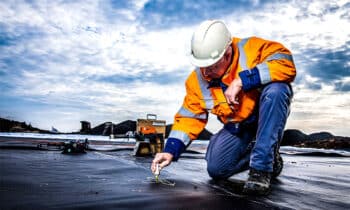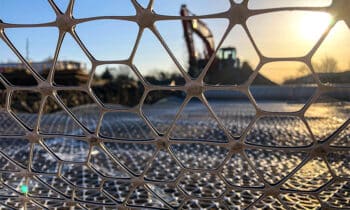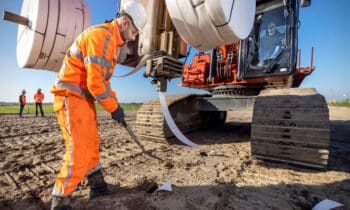
Economical design with geo-plastics
Geosynthetics are still an "outlier" in geotechnical and road construction. Even at colleges and universities, their use is hardly taught. A shame, because in many cases it leads to an economically and environmentally more favorable design. The lack of knowledge means that many engineering firms struggle with the use of geosynthetics in geotechnical engineering or road construction. We are filling that gap. These are the words of Theo Huijbregts of Geologics, specialized in advice and design of geosynthetics in road construction, geotechnical engineering and environmental applications.
Geosynthetics in geotechnical and road construction are relatively new by Dutch standards, acknowledges Huijbregts, who himself has more than 35 years of experience in this field. "It was only in the 1980s that the first projects were realized in road construction, while the use of geotextiles in hydraulic engineering goes back much further. Incidentally, very small projects, such as small retaining walls and steep embankments, were started at the time to counter the 'fear' of using reinforced soil structures. After it all indeed turned out to work well, it actually didn't become a more accepted method until the mid-1990s." During that period, a design guideline was developed, which we still know as the CUR 198 and was updated a few years ago to a second revised version.
Artworks
According to Huijbregts, the change in procurement rules after the turn of the century has been the biggest driver for the widespread application of reinforced soil structures. "Traditionally, the solutions were predefined in specifications, whereas with the Design & Build system the interpretation is left to the market, albeit with a number of preconditions at a higher level. From that time on, large structures were also designed with reinforced soil. After all, it is a much more favorable solution, both economically and environmentally. Our first major project was the sunken tunnel in the A73 near Tegelen. A large D&C-type project with two walls of 1 kilometer length each in reinforced soil. Since then, reinforced soil construction has been considered for all major projects involving junctions and, in eight out of ten cases, has been implemented as such. Most recent projects we have contributed to are the Groningen Ring Road, retaining walls at area development Ooijen-Wanssum and junction Joure, and the A15/A16. And now we are calculating for various parties on the A9 at the Badhoevedorp-Hoofddorp section."

Wind farms
In addition to stabilizing structures, reinforced soil construction also lends itself very well to the realization of wind farms, especially crane stands and temporary construction roads. "Such projects are usually realized in areas where the bearing capacity is not so good," Huijbregts knows. "On the other hand, turbines are getting higher and higher to hub heights of up to 135 meters. This means that the cranes that are deployed are also increasingly higher and heavier. And those high loads have to be carried off properly. This can be done in a relatively simple way with geosynthetics, including for all construction roads leading to the site. Our first special project was Windpark Noordoostpolder near Urk where, based on previous experience with a project in Asia, we provided an alternative solution for a non-substantial construction consisting of a reinforced soil structure with geocells (today Stratum® mentioned). More or less the only solution that fit within the permit that had been granted. The design was then verified and approved by two engineering firms. That was the start for us."
After the Noordoostpolder wind farm, Geologics has engineered numerous more wind farms, including Windpark Wieringermeer with 100 turbines. Huijbregts: "The contractor hired us to develop a 'fit for purpose' each time. Based on soil research, it was determined which solution was most suitable. The soil in the Netherlands varies greatly. At this wind farm we used geosynthetics in different applications, such as a cellular structure and at yet other locations layers with geogrids. Roads can also be perfectly stabilized with geosynthetics to bear the extremely heavy loads on the weak subsoil. We have many decades and experience, a wide network and work with all suppliers, so we use the best product properties to arrive at the most economical as well as environmental solution."




